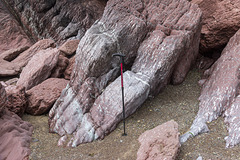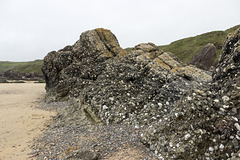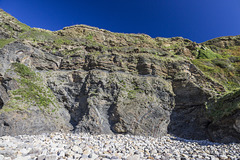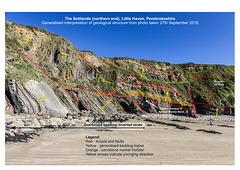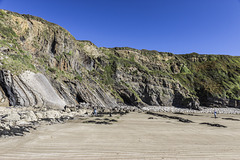
Geological structures
Folder: Geology and Earth Science
Photos illustrating geological structures such as folds, faults, joints, etc.
Gravel Bay - Moor Cliffs Formation with calcretes…
| |
|
|
Freshwater West, Gravel Bay and East Pickard Bay
Moor Cliffs Formation in Gravel Bay.
This photo shows a closer view of the mainly reddened mudstone beds in the Moor Cliffs Formation at the western end of Gravel Bay. The white mottling in the mudstones shows extensive calcrete soil horizons. The sequence is dipping to the north (right) at approx. 65°.
The walking stick is about 0.9 m long.
Background:
The Moor Cliffs Formation overlies the Freshwater East conglomerates, seen in previous photos, and spans the boundary between the Silurian and Devonian periods. It consists of red mudstones and siltstones with occasional thin sandstone beds. These were deposited on a low-reflief floodplain at the edge of an arid continental margin, the sandstones being deposited by seasonal braided streams, the muds and silts deposited in ephemeral marginal lakes. When not inundated, the muds and silts developed carbonate-rich calcrete (caliche) soil horizons along dessication cracks, burrows and early plant root systems.
Gravel Bay - Moor Cliffs Formation with calcretes…
| |
|
Freshwater West, Gravel Bay and East Pickard Bay
Moor Cliffs Formation in Gravel Bay.
This photo shows the mainly reddened mudstone beds in the Moor Cliffs Formation at the western end of Gravel Bay. The white mottling in the mudstones shows extensive calcrete soil horizons. The sequence is dipping to the north (right) at approx. 65°.
The walking stick is about 0.9 m long.
Background:
The Moor Cliffs Formation overlies the Freshwater East conglomerates, seen in previous photos, and spans the boundary between the Silurian and Devonian periods. It consists of red mudstones and siltstones with occasional thin sandstone beds. These were deposited on a low-reflief floodplain at the edge of an arid continental margin, the sandstones being deposited by seasonal braided streams, the muds and silts deposited in ephemeral marginal lakes. When not inundated, the muds and silts developed carbonate-rich calcrete (caliche) soil horizons along dessication cracks, burrows and early plant root systems.
Conglomerates at Gravel Bay
| |
|
|
|
Freshwater West, Gravel Bay and East Pickard Bay
Massive conglomerates and grey sandstones dipping steeply to the north (right) of the Freshwater East Formation (note name) at Gravel Bay, situated at the northern end of the large Freshwater West bay in south Pembrokeshire. The walking stick is 0.9 m long.
The Freshwater East Formation marks the beginning of 'Old Red Sandstone' type of sediments, formerly believed to be at the base of the Devonian, but now assigned to the uppermost Silurian. The pebbles and cobbles in the conglomerates mostly consist of white vein quartz and quartzite, grey sandstones and darker sitstones. These were depositied in an alluvial fan settting on a shallow floodplain in increasingly arid conditions.
West of Telpyn Point - fault in Telpyn Point Sands…
| |
|
Telpyn Point to Amroth
Between Amroth and Telpyn Point, magnificent cliff sections expose the upper Namurian sequence of deltaic channel-fill sandstones and intervening shale sequences.
This photo shows a normal fault (in the centre) downthrowing approx.10 m to the east (right).
The dark band just below the top of the cliff on the eastern side is a thin coaly horizon. Overlying this are mudstones of the Gastrioceras subcrenatum Marine Band which marks the base of the Coal Measures.
The main part of the cliff section is in the Telpyn Point Sandstone (formerly designated as the Upper Sandstone), the uppermost main sandstone in the Namurian, and originally known as the 'Farewell Rock', so called because exploratory boreholes and shafts for coal penetrating the sandstone would no longer encounter any workable coals. Underlying the sandstone is a shale sequence.
See notes for details.
Marros west cliffs
| |
|
|
Marros Sands to Amroth
Just east of Amroth, we cross the county boundary into Carmarthenshire. The fine beach of Marros Sands, some 4 km east of Amroth is relatively isolated between Telpyn Point and Ragwen Point. There is no road access; the only way to get here is along the coastal paths, along the beach at lowest tide, or by boat.
The cliffs immediately south of Top Castle hill fort are comprised of shales of the Namurian-age Bishopston Mudstone Formation (Middle Shale Group). Erosion along joint planes has produced a series of scalloped caves and collapses, and remnant low stacks and reefs on the wave-cut platform.
Structurally, these rocks are almost completely undisturbed, compared with the thrusts and folds encountered just a few miles to the west, between Amroth and Tenby.
Little Settlands - inverted thin coals and disturb…
| |
|
Structural geology of Little Haven and The Settlands
The cliffs from Little Haven to Broad Haven (and northward) display a spectacular range of geological structures, folding, faulting and thrusting, mainly in the Lower Coal Measures. The relatively weak mudstone and shale-dominated sequences show much incompetent deformation: tight, thrusted and overturned folds, in contrast to the thicker, stronger, sandstones which have formed relatively open and concentric folds.
Immediately north of The Rain headland is a small embayment: 'Little Settlands'. Here, a chaotic looking series of disturbed bedding and downward-facing small folds are in contact with a thin coal. The whole sequence is inverted, the inversion being a continuation of the overturned structure seen on The Rain and the northern end of the main Settlands bay.
The coal is completely inverted ('up' is to down to the left). Three thin leaves of coal are visible here. Furthest to the left is the true upper leaf approx. 8 cm thick. This is underlain by pale grey seatearth (behind the walking stick), then another two thin bands of coal one by the stick handle and another beyond that. There appears to be a shear plane to the right of the stick handle; the coal leaf which uppermost in the photo may be a structural duplication repeat of the 8 cm coal leaf. See notes.
The stick is 90 cm long.
Little Settlands - incompetent deformation 2
| |
|
Structural geology of Little Haven and The Settlands
The cliffs from Little Haven to Broad Haven (and northward) display a spectacular range of geological structures, folding, faulting and thrusting, mainly in the Lower Coal Measures. The relatively weak mudstone and shale-dominated sequences show much incompetent deformation: tight, thrusted and overturned folds, in contrast to the thicker, stronger, sandstones which have formed relatively open and concentric folds.
Immediately north of The Rain headland is a small embayment: 'Little Settlands'. Here, a chaotic looking series of disturbed bedding and downward-facing small folds are in contact with a thin coal. The whole sequence is inverted, the inversion being a continuation of the overturned structure seen on The Rain and the northern end of the main Settlands bay.
Downward-facing means that the way-up, younging direction, of the folds is downwards, rather than the normal upwards. The evidence for the way up is provided by small scale (too small to be seen clearly in this photo) sedimentary slump and load casts on the bases of sandy layers within the predominantly shale and mudstone sequence. The inverted folds are thought to have been initiated immediately prior to the main folding and thrusting event.
This shows a closer view of the downward-facing fold in the previous photo. The younging direction is down towards the lower right, so the structure spanned by the walking stick is actually an overturned and inverted syncline.
The stick is 90 cm long.
Little Settlands - incompetent deformation 1
| |
|
Structural geology of Little Haven and The Settlands
The cliffs from Little Haven to Broad Haven (and northward) display a spectacular range of geological structures, folding, faulting and thrusting, mainly in the Lower Coal Measures. The relatively weak mudstone and shale-dominated sequences show much incompetent deformation: tight, thrusted and overturned folds, in contrast to the thicker, stronger, sandstones which have formed relatively open and concentric folds.
Immediately north of The Rain headland is a small embayment: 'Little Settlands'. Here, a chaotic looking series of disturbed bedding and downward-facing small folds are in contact with a thin coal. The whole sequence is inverted, the inversion being a continuation of the overturned structure seen on The Rain and the northern end of the main Settlands bay, e.g. on the left in the previous photo here:
Downward-facing means that the way-up, younging direction, of the folds is downwards, rather than the normal upwards. So the structure at the lower right (see note) which looks like an overturned anticline is actually an inverted syncline. The evidence for the way up is provided by small scale (too small to be seen clearly in this photo) sedimentary slump and load casts on the bases of sandy layers within the predominantly shale and mudstone sequence. The inverted folds are thought to have been initiated immediately prior to the main folding and thrusting event.
The coal is completely inverted ('up' is to down to the left) and separated from the inverted folds by a prominent shear plane just below the bottom of the walking stick and running up towards the upper left.
The stick is 90 cm long.
Little Haven - The Settlands; detail of overturned…
| |
|
|
Structural geology of Little Haven and The Settlands
The cliffs from Little Haven to Broad Haven (and northward) display a spectacular range of geological structures, folding, faulting and thrusting, mainly in the Lower Coal Measures. The relatively weak mudstone and shale-dominated sequences show much incompetent deformation: tight, thrusted and overturned folds, in contrast to the thicker, stronger, sandstones which have formed relatively open and concentric folds.
This is a close-up view of the prominent overturned, nearly recumbent, chevron-style anticline at the northern end of The Settlands. The relatively weak mudstone and shale sequence has deformed incompetently, with some thickening in the hinge zone.The dark shale bed just below the centre of the photo is at the horizon of the Amman Marine Band.
The overturned northern limb of the fold is separated from the nearly horizontal upper limb by a near-horizontal thrust. Below this thrust, disturbed, separate, repeated portions of the hinge zone are visible, one of which has developed axial planar cleavage in the grey seatearth with brown ironstone bands and nodules.
Above the anticline, another significant, higher, thrust has carried more sandy beds over the top.
See notes for individual descriptions of areas on the photo.
Little Haven - The Settlands; detail of incompeten…
| |
|
|
Structural geology of Little Haven and The Settlands
The cliffs from Little Haven to Broad Haven (and northward) display a spectacular range of geological structures, folding, faulting and thrusting, mainly in the Lower Coal Measures. The relatively weak mudstone and shale-dominated sequences show much incompetent deformation: tight, thrusted and overturned folds, in contrast to the thicker, stronger, sandstones which have formed relatively open and concentric folds.
This is a closer view of the complexly folded and thrusted sequence in the central part of the The Settlands. The relatively weak mudstone and shale sequence has deformed incompetently.
In the centre, an anticline with a vertical/slightly overturned northern limb is separated by a near-horizontal thrust from the gently dipping shales just above the beach pebbles.
To the right, a curved slice of siltstones/thin sandstones is itself thrusted over the horizontal thrust. The dark shale bed in the centre of the photo is approximately at the horizon of the Amman Marine Band, which can be followed, despite the structural complexity, northwards (left) to The Rain headland.
See notes for individual descriptions of areas on the photo.
Little Haven - The Settlands; detail of incompeten…
| |
|
Structural geology of Little Haven and The Settlands
The cliffs from Little Haven to Broad Haven (and northward) display a spectacular range of geological structures, folding, faulting and thrusting, mainly in the Lower Coal Measures. The relatively weak mudstone and shale-dominated sequences show much incompetent deformation: tight, thrusted and overturned folds, in contrast to the thicker, stronger, sandstones which have formed relatively open and concentric folds.
This is a closer view of the complexly folded and thrusted sequence in the central part of the The Settlands. The reatively weak mudstone and shale sequence has deformed incompetently, in stark contrast to the small anticline a few metres to the south (right) in the previous photo. The dark shale bed in the centre of the photo is approximately at the horizon of the Amman Marine Band, which can be followed, despite the structural complexity, northwards (left) to The Rain headland.
See notes for individual descriptions of areas on the photo.
Little Haven - The Settlands; detail of southern a…
| |
|
Structural geology of Little Haven and The Settlands
The cliffs from Little Haven to Broad Haven (and northward) display a spectacular range of geological structures, folding, faulting and thrusting, mainly in the Lower Coal Measures. The relatively weak mudstone and shale-dominated sequences show much incompetent deformation: tight, thrusted and overturned folds, in contrast to the thicker, stronger, sandstones which have formed relatively open and concentric folds.
This is a closer view of the small anticline at the southern end of The Settlands. This open, concentric fold is comprised mostly of strong, competent sandstones in the core, overlain by dark shaly beds. The sandsones may possibly be correlated with the sandstones in the large and well-developed Fox Hole anticline situated immediately to the south (right), althought there is a significant fault between the two features and the correlation is by no means certain.
Little Haven - The Settlands; recumbent fold, thru…
| |
|
|
Structural geology of Little Haven and The Settlands
The cliffs from Little Haven to Broad Haven (and northward) display a spectacular range of geological structures, folding, faulting and thrusting, mainly in the Lower Coal Measures. The relatively weak mudstone and shale-dominated sequences show much incompetent deformation: tight, thrusted and overturned folds, in contrast to the thicker, stronger, sandstones which have formed relatively open and concentric folds.
The cliffs at the east end of The Settlands bay display a series of complexly thrusted, folded and faulted Lower Coal Measures rocks. The folds are overturned to the north, becoming nearly recumbent (low-angle fold axes) near the northern headland, known as 'The Rain', seen here on the left. The complexity of the folding is mostly due to the predominance of weak mudstones and shales which undergo incompetent deformation, in contrast to the open folding in the strong sandstone Fox Hole anticline in previous photos, and in the less disturbed but overturned sandstone sequence on the left of this photo.
The principal structure in the central region of the photo is a nearly recumbent fold with several associated thrusts. There are two main thrusts and several smaller thrust splays which result in repetition of the strata, mainly around the horizon of the Amman Marine Band. Yellow arrows indicate the 'way up', younging direction, of the beds.
Interpretation linework carried out using Affinity Designer software.
More detailed view here:
This is a generalised geological interpretation of the previous photo here:
Little Haven - The Settlands; recumbent fold, thru…
| |
|
|
Structural geology of Little Haven and The Settlands
The cliffs from Little Haven to Broad Haven (and northward) display a spectacular range of geological structures, folding, faulting and thrusting, mainly in the Lower Coal Measures. The relatively weak mudstone and shale-dominated sequences show much incompetent deformation: tight, thrusted and overturned folds, in contrast to the thicker, stronger, sandstones which have formed relatively open and concentric folds.
The cliffs at the east end of The Settlands bay display a series of complexly thrusted, folded and faulted Lower Coal Measures rocks. The folds are overturned to the north, becoming nearly recumbent (low-angle fold axes) near the northern headland, known as 'The Rain', seen here on the left. The complexity of the folding is mostly due to the predominance of weak mudstones and shales which undergo incompetent deformation, in contrast to the open folding in the strong sandstone Fox Hole anticline in previous photos, and in the less disturbed but overturned sandstone sequence on the left of this photo.
The principal structure in the central region of the photo is a nearly recumbent fold with several associated thrusts. There are two main thrusts and several smaller thrust splays which result in repetition of the strata, mainly around the horizon of the Amman Marine Band.
More detailed view here:
A generalised geological interpretation is given in the adjacent photo here:
Little Haven - The Settlands panorama - geological…
| |
|
Structural geology of Little Haven and The Settlands
The cliffs from Little Haven to Broad Haven (and northward) display a spectacular range of geological structures, folding, faulting and thrusting, mainly in the Lower Coal Measures. The relatively weak mudstone and shale-dominated sequences show much incompetent deformation: tight, thrusted and overturned folds, in contrast to the thicker, stronger, sandstones which have formed relatively open and concentric folds.
The cliffs at the east end of the The Settlands bay display a series of complexly thrusted, folded and faulted Lower Coal Measures rocks. The folds are overturned to the north, becoming nearly recumbent (low-angle fold axes) near the northern headland, known as 'The Rain'. The complexity of the folding is mostly due to the predominance of weak mudstones and shales which undergo incompetent deformation, in contrast to the open folding in the strong sandstone Fox Hole anticline in previous photos.
This is a generalised geological interpretation of the visible structures in the previous photo:
www.ipernity.com/doc/earthwatcher/49995364
There are two main thrusts and several smaller thrust splays which result in repetition of the strata, mainly around the horizon of the Amman Marine Band. The weaker mud-rich rocks have deformed and thickened into the axial crests of the folds and usually display a degree of axial planar cleavage. The folds are mainly overturned anticlines; the synclines have been cut out by thrusting. The small anticline visible on the right may possibly be comprised of the uppermost beds of the Fox Hole sandstone, but the correlation is very uncertain.
See notes for links to detailed views.
The background photo is a panoramic view consisting of three landscape photos stiched together in Affinity Photo sofware. Interpretation linework carried out using Affinity Designer software.
Little Haven - The Settlands panorama
| |
|
Structural geology of Little Haven and The Settlands
The cliffs from Little Haven to Broad Haven (and northward) display a spectacular range of geological structures, folding, faulting and thrusting, mainly in the Lower Coal Measures. The relatively weak mudstone and shale-dominated sequences show much incompetent deformation: tight, thrusted and overturned folds, in contrast to the thicker, stronger, sandstones which have formed relatively open and concentric folds.
The cliffs at the east end of the The Settlands bay display a series of complexly thrusted, folded and faulted Lower Coal Measures rocks. The folds are overturned to the north, becoming nearly recumbent (low-angle fold axes) near the northern headland, known as 'The Rain'. The complexity of the folding is mostly due to the predominance of weak mudstones and shales which undergo incompetent deformation, in contrast to the open folding in the strong sandstone Fox Hole anticline in previous photos.
There are two main thrusts and several smaller thrust splays which result in repetition of the strata, mainly around the horizon of the Amman Marine Band. The weaker mud-rich rocks have deformed and thickened into the axial crests of the folds and usually display a degree of axial planar cleavage. The folds are mainly overturned anticlines; the synclines have been cut out by thrusting. The small anticline visible on the right may possibly be comprised of the uppermost beds of the Fox Hole sandstone, but the correlation is very uncertain.
See notes for links to detailed views.
The adjacent photo gives a geological interpretation of the visible structures.
www.ipernity.com/doc/earthwatcher/49998924
This photo is a panoramic view consisting of three landscape photos stiched together in Affinity Photo sofware.
Fox Hole Anticline - northern limb with mine adit
| |
|
Structural geology of Little Haven and The Settlands
The cliffs from Little Haven to Broad Haven (and northward) display a spectacular range of geological structures, folding, faulting and thrusting, mainly in the Lower Coal Measures. The relatively weak mudstone and shale-dominated sequences show much incompetent deformation: tight, thrusted and overturned folds, in contrast to the thicker, stronger, sandstones which have formed relatively open and concentric folds.
The northern limb of the Fox Hole anticline forms the southern headland of The Settlands bay. The style of folding is open and concentric, largely due to the thick (approx 70 m in total) and competent (strong) nature of the sandstone of which it is comprised. At the western end of the headland the bedding dips at about 30° to the north, but this steepens along its length to become near-vertical at the eastern end of the headland.
This is a view from The Settlands looking head-on at the steeply dipping bedding surfaces. The bedding is cut by nurmerous joints (fractures). Just left of centre is a fenced-off mine entrance a few metres above beach level. This is thought to be a former drainage level to dewater coal mine workings, possibly in the core of the anticline and perhaps further inland.
Fox Hole Anticline - northern limb jointing with c…
| |
|
|
|
Structural geology of Little Haven and The Settlands
The cliffs from Little Haven to Broad Haven (and northward) display a spectacular range of geological structures, folding, faulting and thrusting, mainly in the Lower Coal Measures. The relatively weak mudstone and shale-dominated sequences show much incompetent deformation: tight, thrusted and overturned folds, in contrast to the thicker, stronger, sandstones which have formed relatively open and concentric folds.
The northern limb of the Fox Hole anticline forms the southern headland of The Settlands bay. The style of folding is open and concentric, largely due to the thick (approx 70 m in total) and competent (strong) nature of the sandstone of which it is comprised. At the western end of the headland the bedding dips at about 30° to the north, but this steepens along its length to become near-vertical at the eastern end of the headland.
This is a view looking head-on at the steeply dipping bedding surfaces. The bedding is cut by nurmerous joints (fractures) which in this case has been enlarged by erosion to form a shallow sea cave at beach level. Someone has lit a candle on a rack inside the cave. Perhaps a memorial to a loved one?
Jump to top
RSS feed- Latest items - Subscribe to the latest items added to this album
- ipernity © 2007-2024
- Help & Contact
|
Club news
|
About ipernity
|
History |
ipernity Club & Prices |
Guide of good conduct
Donate | Group guidelines | Privacy policy | Terms of use | Statutes | In memoria -
Facebook
Twitter

